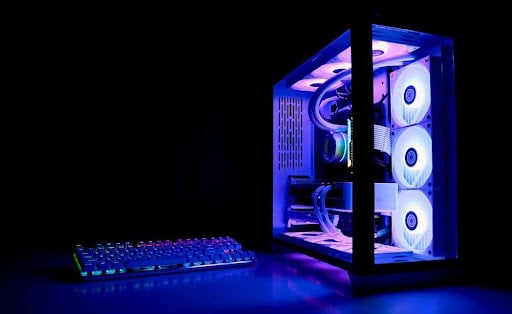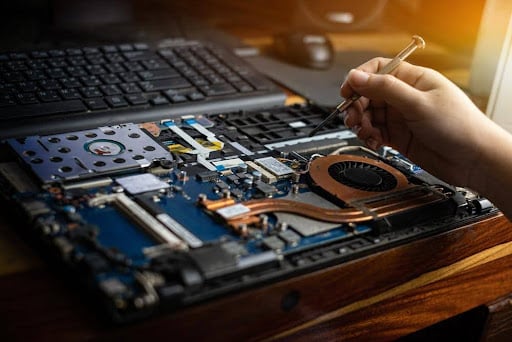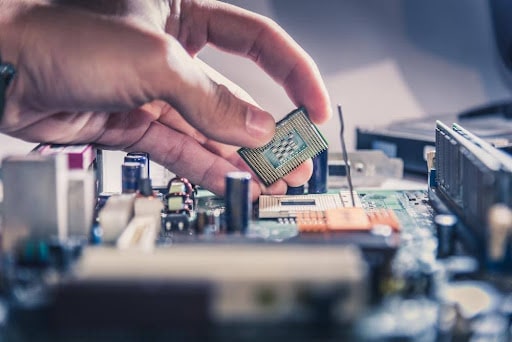Proper cooling helps maintain the performance and longevity of your computer’s CPU. The CPU is the brain of your system and generates a large amount of heat during operation. This heat must be effectively dissipated to prevent performance throttling or potential damage to your PC’s components.
One vital factor that impacts CPU cooling efficiency is the mounting pressure. Understanding this concept and its implications can help you find the perfect balance between effective cooling and hardware protection.
Basics of CPU Cooling
Effective CPU cooling is essential for two key reasons: performance and longevity. When a CPU operates at excessively high temperatures, it throttles its performance to prevent damage. This translates to slower processing speeds and potential lags in demanding applications and gaming. Extreme heat can also degrade the CPU’s internal components, shortening its lifespan.
There are two main types of CPU cooling solutions:
- Air cooling: This traditional method uses a heat sink — a metal block with numerous fins — to dissipate heat generated by the CPU. A fan mounted on the heat sink actively draws cool air across the fins, transferring heat away from the CPU.
Common air cooling solutions come in various shapes and sizes. Tower coolers offer the most cooling potential with large heat sinks and powerful fans. For smaller PC builds, low-profile coolers provide a more compact alternative.
- Liquid cooling: This advanced method uses a closed-loop system with a water block that absorbs heat from the CPU. The heat is transferred through tubing to a radiator equipped with fans, dissipating into the surrounding air.
Liquid cooling typically comes in AIO (All-in-One) coolers, pre-filled and sealed liquid cooling systems that offer excellent performance without the complexity of custom loops.
What Is Mounting Pressure?
Mounting pressure refers to the controlled force the CPU cooler applies onto the CPU, specifically on the thermal interface material (TIM) between them. This TIM, often called thermal paste, helps efficiently transfer heat.
Microscopic irregularities on the surfaces of the CPU and the cooler base cause the formation of air pockets. Mounting pressure helps to squeeze the TIM into these pockets, ensuring a more complete and uniform layer for maximum heat conduction. Think of it like spreading butter on toast — you want a thin, even layer to maximize contact.
Mounting pressure is typically measured in pounds per square inch (PSI) or newtons per square centimeter (N/cm²). However, manufacturers rarely provide these values and are more for reference and research purposes. The pressure you achieve during installation depends on the cooler design, mounting hardware, and tightening technique.
The Impact of Mounting Pressure on CPU Cooling
Mounting pressure directly affects the thermal conductivity between the CPU and the cooler. Here’s a breakdown of how it works:
- Optimal pressure. An ideal pressure level ensures positive contact between the entire surface of the cooler base and the CPU’s heat spreader. This minimizes air bubbles or voids within the TIM layer, promoting efficient heat transfer from the CPU core to the cooler. The result? Lower CPU temperatures and a more stable system.
- Insufficient pressure. If the mounting pressure is not strong enough, air pockets will remain trapped within the TIM. These air pockets act as thermal insulators, limiting heat transfer. This can lead to higher CPU temperatures and potential overheating under load.
- Excessive pressure. Applying too much pressure can do more harm than good, leading to various issues. For instance, the motherboard’s circuit board, or PCB, might bend under the strain, risking damage to sensitive parts or causing electrical shorts. The CPU or its socket could also sustain damage like cracked heat spreaders or physical damage to the socket. Additionally, too much pressure can make the cooler vibrate excessively, increasing the noise levels, which is a problem for anyone who values a quiet PC.
Most manufacturers will provide installation instructions with torque specifications or warnings regarding excessive pressure. Exceeding these recommendations can void your warranty and potentially damage your components.
Finding the Right Pressure
There’s no universal perfect mounting pressure that applies to every CPU cooler and CPU combination. Several factors influence the required pressure your PC needs, including:
- Cooler size. Different coolers have varying baseplate sizes and mounting mechanisms. A tower cooler with a large, heavy baseplate might require less pressure than a smaller, lighter cooler to achieve optimal contact.
- CPU type. CPUs also come in different shapes and sizes, with varying heat spreader designs and case fan sizes. For instance, a high-performance CPU with a large, flat heat spreader might require slightly different pressure than a lower-powered CPU with a smaller, more uneven heat spreader.
- Motherboard construction. The rigidity of the motherboard itself can also play a role. A more sturdy motherboard with a thicker PCB might be able to handle slightly higher mounting pressure without warping.
Tips for Optimizing Mounting Pressure
Getting the mounting pressure right is key to keeping your computer running smoothly and quietly. Here are some tips to help you optimize that delicate balance without going overboard.
- Gradual tightening. The key is to apply pressure evenly and gradually. Most CPU coolers use a screw-based mounting mechanism. Tighten each screw in a crisscross pattern, turning each screw a quarter or half turn at a time. This ensures an even distribution of pressure across the cooler base.
- Feeling for resistance. As you tighten the screws, you’ll reach a point where you feel a slight increase in resistance. This is a good sign that you’ve achieved sufficient pressure. Avoid forcing the screws any further, especially if the manufacturer doesn’t provide specific torque specifications.
- Testing for optimal pressure. Once the cooler is installed, monitor your CPU temperature under load. You can use software like HWMonitor or CoreTemp to monitor these values. Run a stress test with a program like Prime95 or AIDA64 for around five to 10 minutes and observe the CPU temperature.
You’ve likely achieved a good balance if the temperature remains within acceptable limits (typically below 80°C). However, if the temperature is higher than expected, slightly increase the pressure on the screws (within safe limits) and retest.
Maximize Your PC Performance
By understanding the role of mounting pressure in CPU cooling and applying the tips outlined above, you can ensure your CPU cooler operates at peak efficiency. This translates to cooler CPU temperatures, optimal system performance, and a longer lifespan for your valuable PC components.











